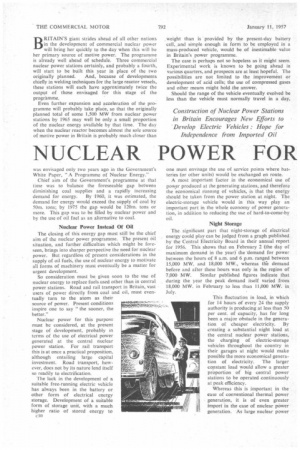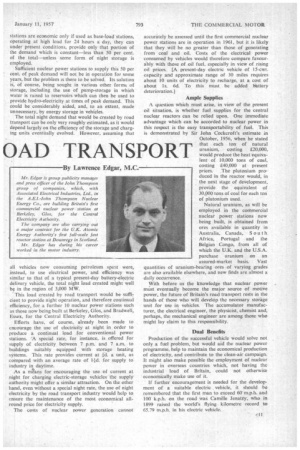NUCLEAR POWER FOR OAD TRANSPORT
Page 48

Page 49

If you've noticed an error in this article please click here to report it so we can fix it.
By Lawrence Edgar, M.C.
BRITAIN'S giant strides ahead of all other nations in the development of commercial nuclear power will bring her quickly to the day when this will be her primary source of motive power. The programme is already well ahead of schedule. Three commercial nuclear power stations certainly, and probably a fourth, will start to be built this year in place of the two
originally planned. And, because of developments chiefly in welding techniques for the large reactor vessels, these stations will each have approximately twice the output of those envisaged for this stage of the programme.
Even further expansion and acceleration of the programme will probably take place, so that the originally planned total of some 1,500 MW from nuclear power stations by 1965 may well be only a small proportion of the nuclear energy available by that time. The day when the nuclear reactor becomes almost the sole source of motive power in Britain is probably much closer than was envisaged only two years ago in the Government's White Paper, "A Programme of Nuclear Energy."
Chief aim of the Government's programme at that time was to balance the foreseeable gap between diminishing coal supplies and a rapidly increasing demand for energy. By 1960, it was estimated, the demand for energy would exceed the supply of coal by 5Orn. tons; by 1975 the gap would be 120m. tons or more. This gap was to be filled by nuclear power and by the use of oil fuel as an alternative to coal.
Nuclear Power Instead Of Oil
The closing of this energy gap must still be the chief aim of the nuclear power programme. The present oil situation, and further difficulties which might be foreseen, brings into sharper perspective the need for nuclear power. But regardless of present considerations in the supply of oil fuels, the use of nuclear energy to motivate all forms of machinery must eventually be a matter for urgent development.
So consideration must be given soon to the use of nuclear energy to replace fuels used other than in central power stations_ Road and rail transport in Britain, vast users of power directly from coal and oil, must eventually turn to the atom as their source of power. Present conditions inspire one to say "the sooner, the better."
Nuclear power for this purpose must be considered, at the present stage of development, probably in terms of the use of electrical power generated at the central nuclear power station. For rail transport this is at once a practical proposition, although entailing large capital investment. Road transport, however, does not by its nature lend itself so readily to electrification.
The lack in the development of a suitable free-running electric vehicle has always been in the battery or other form. of electrical energy storage. Development of a suitable form of storage unit, with a much higher ratio of stored energy to
ct 0 weight than is provided by the present-day battery cell,, and simple enough in form to be employed in a mass-produced vehicle, would be of inestimable value in Britain's power programme.
The case is perhaps not so hopeless as it might seem. Experimental work is known to be going ahead in various quarters, and prospects are at least hopeful. The possibilities are not limited to the improvement or development of acid cells; the use of compressed gases and other means might hold the answer.
Should the range of the vehicle eventually evolved be less than the vehicle must normally travel in a day, one must envisage the use of service points where batteries (or other units) would be exchanged en route.
A most important factor in the economical use of power produced at the generating stations, and therefore the economical running of vehicles, is that the energy should be taken from the power station at night. The electric-storage vehicle would in this way play an important part in the whole economy of power generation, in addition to reducing the use of hard-to-come-by oil.
Night Storage The significant part that night-storage of electrical energy could play can be judged from a graph published by the Central Electricity Board in their annual report for 1956. This shows that on February 2 (the day of maximum demand in the year). the 'demand for power between the hours of 8 a.m. and 6 p.m. ranged between 15,000 MW. and 18,000 MW., whereas the demand before and after these hours was only in the region of 7,000 MW. Similar published figures indicate that during the year the peak demand itself varied from 18,000 MW. in February to less than 11,000 MW. in July.
This fluctuation in load, in which for 14 hours of every 24 the supply authority is producing at less than 50 per cent. of capacity, has for long been a major obstacle in the generation of cheaper electricity. By creating a substantial night load at the central nuclear power stations, the charging of electric-storage vehicles throughout the country in their garages at night would make possible the more economical generation of electricity. The larger constant load would allow a greater proportion of big central power stations to be operated continuously at peak efficiency.
Whereas this is important in the case of conventional thermal power generation, it is of even greater import in the case of nuclear power generation. As large nuclear power
stations are economic only if used as base-load stations, operating at high load for 24 hours a day, they can under present conditions, provide only that portion of the demand which is constant—less than 50 per cent. of the total—unless some form of night storage is employed.
Sufficient nuclear power stations to supply this 50 per cent, of peak demand will not be in operation for some years, but the problem is there to be solved. Its solution is, of course, being sought in various other forms of storage, including the use of pump-storage in which Water is raised to reservoirs which can then be used to provide hydro-electricity at times of peak demand. This could be considerably aided, and, to an extent, made unnecessary, by energy storage in vehicles.
The total night demand that would be created by road transport can be only very roughly estimated, as it would depend largely on the efficiency of the storage and charging units eventually evolved. However, assuming that
all vehicles now consuming petroleum spirit were, instead, to use electrical power, and efficiency was similar to that of a typical present-day battery-electric delivery vehicle, the total night load created might well be in the region of 3,000 MW.
This load created by road transport would be sufficient to provide night operation, and therefore continual efficiency, for a further 10 nuclear power stations such as those now being built at Berkeley, Glos, and Bradwell, Essex, for the Central Electricity Authority.
Efforts have, of course, already been made to encourage the use of electricity at night in order to produce a continual load for conventional power stations. 'A special rate, for instance, is offered for supply of electricity between 7 p.m. and 7 a.m. to buildings suitably • equipped with storage heating systems. This rate provides current at id. a unit, as compared with an average rate of lid, for supply to industry in daytime.
As a means for encouraging the use of current at night for charging electric-storage vehicles the supply authority might offer a similar attraction. On the other hand, even without a special night rate, the use of night electricity by the road transport industry would help to ensure the maintenance of the most economical allround price for electricity supply.
The costs of nuclear power generation cannot accurately be assessed until the first commercial nuclear power stations are in operation in 1961, but it is likely that they will be no greater than those of generating from coal and oil. Costs of the electrical power consumed by vehicles would therefore compare favourably with those of oil fuel, especially in view of rising oil prices. [A present-day electric vehicle of 15-cwt. capacity and approximate range of 30 miles requires about 10 units of electricity to recharge, at a cost of about ls. 6d. To this must be added battery deterioration.]
Ample Supplies
A question which must arise, in view of the present oil situation, is whether fuel supplies for the central nuclear reactors can be relied upon. One immediate advantage which can be accorded to nuclear power in this respect is the easy transportability of fuel. This is demonstrated by Sir John Cockcroft's estimate in October, 1956, when he stated that . each ton of natural uranium, costing £20,000, would produce the heat equivalent of 10,000 tons of coal, costing £40,000 at present prices. The plutonium pro duced in the reactor would, in the next stage of development, provide the equivalent of 30,000 tons of coal for each ton of plutonium used.
Natural uranium, as will be employed in the commercial nuclear power stations now being built, is obtained from ores available in quantity in Australia, Canada, South Africa, Portugal and the Belgian Congo, from all of which the U.K. and the U.S.A. purchase uranium on an assured-market basis. Vast quantities of uranium-bearing ores of varying grades are also available elsewhere, and new finds are almost a daily occurrence.
With before us the knowledge that nuclear power must eventually become the major source of motive power, the future of Britain's road transport rests in the hands of those who will develop the necessary storage unit for use in vehicles. The accumulator manufacturer, the electrical engineer, the physicist, chemist and, perhaps, the mechanical engineer are among those who might lay claim to this responsibility.
Dual Benefits
Production of the successful vehicle would solve not only a fuel problem, but would aid the nuclear power programme, help to maintain the economical production of electricity, and contribute to the clean-air campaign. It might also make possible the employment of nuclear power in overseas countries which, not having the industrial load of Britain, could not otherwise economically make use of it.
If further encouragement is needed for the development of a suitable electric vehicle, it should be remembered that the first man to exceed 60 m.p.h. and 100 k.p.h. on the road was Camille Jenatzy; who in 1899 raised the world's flying kilometre record to 65.79 m.p.h. in his electric vehicle.












































































































